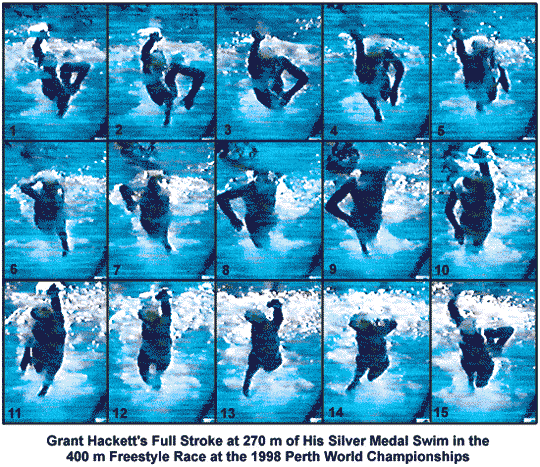HOW CHAMPIONS DO IT
Researched, produced, and prepared by Brent S. Rushall,
Ph.D., R.Psy.

GRANT HACKETT'S FULL STROKE (FRONTAL VIEW) AT 270 m OF HIS SILVER MEDAL SWIM IN THE 400 m FREESTYLE RACE AT THE 1998 PERTH WORLD CHAMPIONSHIPS
Each frame is .1 seconds apart.
NOTABLE FEATURES
- Frame #1: The right arm has just entered. The left arm pull is in an early stage. The left upper arm has medially rotated to leave the elbow "high" and the hand/forearm-propelling surface is positioned for extensive propulsion. The head is well down with the shoulders almost flat. The left leg kicks to counter-balance the right arm entry.
- Frame #2: The right arm remains stretched forward near the surface. The left arm pulls "wide." Adduction pivots the upper arm in the shoulder socket causing the elbow to rotate outward. Muscles on both the back and front of the shoulder provide the power for the adduction. The propelling surface of the combined hand, forearm, and possibly upper arm is clearly demonstrated. Drag turbulence trails the left hand. The left leg completes its kick. The head begins to rotate to the left.
- Frame #3: The right arm continues to be stretched forward near the surface. The right elbow straightens slightly. The left arm continues its hand/forearm propulsion as the upper arm nears the end of adduction. The head continues to turn to the left.
- Frame #4: The right arm almost hyperextends at the elbow preparatory to pulling. The left arm extends backward with its upper segment beginning to rise. The right leg kicks to counter-balance the rising left arm. The head turns further to the left and begins to lift.
- Frame #5: The right arm begins to "press" down. Grant Hackett's "trademark" quick extraction that initiates a fast recovery can be seen by how much of the left arm is visible in this frame compared to the previous frame. Although no breath is taken, the head continues to be held on the side and is slightly elevated.
- Frame #6: The right arm is re-positioned rapidly. The upper arm medially rotates and the elbow flexes keeping the hand close to the midline of the swimmer's system. The left arm is completely out of the water. The shoulders have rolled to their maximum for this stroke. The head remains turned to the left. The left leg has kicked to counter-balance the vertical forces created by the right arm positioning.
- Frame #7: The right arm commences to apply predominantly propulsive forces with the "elbow-up" position established. The right arm also moves outward partly to counter-balance the torque produced by the recovering left arm. As the left arm recovers the head is swept forward with the hairline at the surface. The unnecessary turbulence caused by this action can be seen coming off the swimmer's nose and chin. This high head position causes the hips and thighs to sink. The reader should compare how much larger the frontal surface of the swimmer is in this frame compared to that in Frames #1, #14, and #15. The left leg kick shows the foot being dorsi-flexed possibly to "steer" and maintain the swimmer's system on a direct forward progression.
- Frame #8: The right arm sweeps back as its upper segment rotates in the shoulder joint during adduction. It continues to sweep outside the midline as the left arm recovers. The head is lifted further resulting in an increase in frontal resistance. The turbulence off the head is now clearly visible, its size indicating the magnitude of its detrimental effect.
- Frame #9: Adduction of the upper right arm is nearly complete but propulsion still emanates from the hand/forearm's surface. The right leg kicks as the left arm nears entry. The head turns rapidly to the right while still elevated. Frontal resistance is maximal in this position, that is, streamline is at its worst.
- Frame #10: Right arm propulsion concludes by partially extending. The left arm enters in a fully stretched position. Although turned to the right, the head is inclined back into the water.
- Frame #11: Right arm extraction is almost complete. The left arm remains stretched forward. The top of the head is lowered further.
- Frame #12: The right arm is completely extracted and the left arm begins to be positioned for propulsion. The right leg kicks to counter-balance left arm forces. Very little propulsive force is created. The head, now dipping through the horizontal plane rotates even further just prior to breathing. As a result of the head being lowered, the swimmer's streamline improves.
- Frame #13: The head turns backward and remains tilted down as inhalation occurs. The left arm begins to bend at the elbow and its upper arm medially rotates. The right leg counter-balancing kick is near completion.
- Frame #14: Inhalation is completed and the head rotates back into the water. The left arm continues to be repositioned to effect better propulsion. The right leg is "dragging." Turbulence can be seen coming off the bottom of the foot. The head continues to rotate back toward the pool bottom.
- Frame #15: A moment before the position depicted in Frame #1 is achieved and the stroking cycle recommences.
Grant Hackett is a very fine swimmer. However, two aspects are of concern about his stroking. The first is his head lifting and rotation actions. They cause streamlining to be reduced and produce considerable drag resistance. The second feature is the period in each stroke where little propulsive force seems to be developed. Those inertial lags are fatiguing and also reduce the swimmer's efficiency, factors that are undesirable for a distance swimmer.

Return to Table of Contents for this section.




